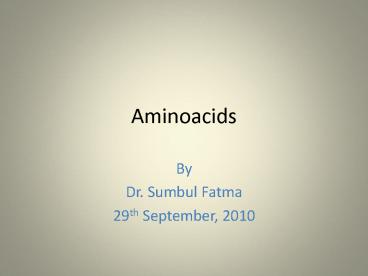Aminoacids - PowerPoint PPT Presentation
1 / 33
Title:
Aminoacids
Description:
... B. Alanine in acid (1) Classification on the basis of side chain Non-polar ... Learning check-3 Solution-3 Amino acid derivatives of importance ... – PowerPoint PPT presentation
Number of Views:105
Avg rating:3.0/5.0
Title: Aminoacids
1
Aminoacids
- By
- Dr. Sumbul Fatma
- 29th September, 2010
2
Types of proteins
- Type Examples
- Structural tendons, cartilage, hair, nails
- Contractile muscles
- Transport hemoglobin
- Storage milk
- Hormonal insulin, growth hormone
- Enzyme catalyzes reactions in cells
- Protection immune response
3
Amino acids
- Building blocks of proteins
- 20 are present in mammalian proteins
4
Structure of amino acids
- Groups attached to a- carbon
- a carboxyl group
- an amino group
- a side chain
5
Examples
- H
- I
- H2NC COOH
- I
- H glycine
- CH3
- I
- H2NC COOH
- I
- H alanine
6
Zwitterions
Net charge is zero on the molecule
7
Isoelectric point
- The pH at which the molecule carries no net
charge - In acidic solution-cationic
- In alkaline solution- anionic
8
Titration curve of glycine
- pK1- pH at which 50 of molecules are in cation
form and 50 are in zwitterion form - pK2- pH at which 50 of molecules are in anion
form and 50 are in zwitterion form - Buffering action is maximum around pK values and
minimum at pI
9
- What if amino acid has more than two ionizable
groups?
10
Titration curve of aspartic acid
11
Learning check-1
- CH3 CH3
- H3NCHCOOH H2NCH2COO
- (1) (2)
- Select from the above structures
- A. Alanine in base.
- B. Alanine in acid.
12
Solution-1
- CH3 CH3
- H3NCHCOOH H2NCH2COO
- (1) (2)
- Select from the above structures
- A. Alanine in base- (2)
- B. Alanine in acid (1)
13
Classification on the basis of side chain
- Non-polar
- Side chain does not bind or give off protons
- Promote hydrophobic interaction
- In aqueous solution- clustered in the interior
- Helps giving a 3-d shape
14
(No Transcript)
15
Proline
- imino acid
- Has a secondary amino group
16
Classification on the basis of side chain
- Polar
- uncharged
- Acids
- Bases
- Hydrophilic
17
Polar uncharged amino acids
- Have zero net charge at neutral pH
- Hydrophillic
18
(No Transcript)
19
Polar acidic amino acids
- Have a negative charge on the R-group
20
Polar basic amino acids
- Have a positive charge on the R-group
21
Learning check-2
- Identify each as (1) polar or (2) nonpolar
- A. NH2CH2COOH (Glycine)
- CH3
- CHOH
- B. NH2CHCOOH (Serine)
22
Solution-2
- Identify each as (1) polar or (2) nonpolar
- A.(2) NH2CH2COOH (Glycine)
- CH3
- CHOH
- B. (1) NH2CHCOOH (Serine)
23
Optical properties of amino acids
- Amino acids having asymmetric carbon atom exhibit
optical activity - The mirror image forms produced with reference to
the a-C atom are called D and L isomers - L-amino acids natural amino acids
- D-amino acids are found in antibiotics (like
Gramicidin-S, Actinomycin-D and Valinomycin) and
in plant and bacterial cell walls - Glycine an exception- no optical activity
24
Stereoisomers/Enantiomers
25
Learning check-3
- All 20 amino acids exist in nature equally as
both D and L stereoisomers - True/False
26
Solution-3
- All 20 amino acids exist in nature equally as
both D and L stereoisomers - False
27
Amino acid derivatives of importance
- Gamma amino butyric acid (GABA, a derivative of
glutamic acid) and dopamine (from tyrosine) are
neurotransmitters - Histamine (Histidine) is the mediator of allergic
reactions - Thyroxine (Tyrosine) is an important thyroid
hormone
28
Peptide bond
- Proteins are made by polymerization of amino
acids through CO-NH bridge - a-carboxyl group of one amino acid reacts with
a-amino group of another amino acid
29
Proteins are made by controlled polymerization of
amino acids
30
Peptides
- 2 aa- dipeptide
- 3-?
- 4- ?
- Upto 10- oligo peptide
- 10-50- polypeptide
- More than 50 - proteins
31
Learning check-4
- What are the possible tripeptides formed from
one each of leucine, glycine, and alanine?
32
Solution-4
Tripeptides possible from one each of leucine,
glycine, and alanine Leu-Gly-Ala Leu-Ala-Gly
Ala-Leu-Gly Ala-Gly-Leu Gly-Ala-Leu Gly-Leu
-Ala
33
References
- Lippincotts Illustrated reviews Biochemistry
4th edition unit 1































